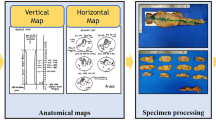Abstract
Background
We measured the sizes of metastatic lymph nodes and the relationships thereof by 18F-fluorodeoxyglucose positron emission tomography/computer tomography (PET/CT). We identified risk factors for nodal upstaging in patients with esophageal squamous cell carcinoma (ESCC).
Methods
Eighty-five patients with ESCC who underwent esophagectomy with extensive mediastinal lymphadenectomy were assessed. Two radiologists blinded to pathology data reviewed PET/CT scans, evaluating both primary tumors and lymph node involvement. A pathologist examined all metastatic lymph nodes in terms of maximal diameter (LNmax), the size of the metastatic focus (Fmax), and the metastasis occupation ratio (MOR = Fmax/LNmax).
Results
The maximal tumor length averaged 2.9 ± 0.2 cm and the mean SUVmax of the primary lesion 5.3 ± 0.5. On PET/CT scans, 26 (30.6 %) patients exhibited nodal metastasis and 59 (69.4 %) did not. Pathology grades of pN0, pN1, pN2, and pN3 were assigned to 45 (52.9 %), 24 (28.2 %), 13 (15.3 %), and 3 (3.5 %) patients, respectively. Nodal upstaging was evident in 29 (34.1 %) cases. In 123 metastatic nodes of 4212 nodes dissected, the LNmax was 6.60 ± 0.39 mm, the Fmax 4.47 ± 0.35 mm, and the MOR 0.68 ± 0.03. Of 123 nodes, 85 (69.1 %) were retrieved from PET-negative stations, and the LNmax and Fmax values of these nodes were 5.88 ± 0.42 and 3.75 ± 0.31 mm, respectively. Upon multivariate analysis, tumor length (OR 1.666, p = 0.019) and lymphovascular invasion (OR 41.038, p < 0.001) were risk factors for nodal upstaging.
Conclusion
A significant proportion of nodal metastases were too small to detect via PET/CT imaging. Therefore, meticulous lymph node dissection might be helpful in ESCC patients.

Similar content being viewed by others
References
Kuwano H, Nakajima M, Miyazaki T et al (2003) Distinctive clinicopathological characteristics in esophageal squamous cell carcinoma. Ann Thorac Cardiovasc Surg 9:6–13
Hosch SB, Stoecklein NH, Pichlmeier U et al (2001) Esophageal cancer: the mode of lymphatic tumor cell spread and its prognostic significance. J Clin Oncol 19:1970–1975
Rice TW, Blackstone EH, Rusch VW (2010) 7th edition of the AJCC Cancer Staging Manual: esophagus and esophagogastric junction. Ann Surg Oncol 17:1721–1724
Kato H, Kimura H, Nakajima M et al (2008) The additional value of integrated PET/CT over PET in initial lymph node staging of esophageal cancer. Oncol Rep 20:857–862
Yuan S, Yu Y, Chao KC et al (2006) Additional value of PET/CT over PET in assessment of locoregional lymph nodes in thoracic esophageal squamous cell cancer. J Nucl Med 47:1255–1259
Choi JY, Lee KH, Shim YM et al (2000) Improved detection of individual nodal involvement in squamous cell carcinoma of the esophagus by FDG PET. J Nucl Med 41:808–815
Nomori H, Watanabe K, Ohtsuka T et al (2004) The size of metastatic foci and lymph nodes yielding false-negative and false-positive lymph node staging with positron emission tomography in patients with lung cancer. J Thorac Cardiovasc Surg 127:1087–1092
Räsänen JV, Sihvo EI, Knuuti MJ et al (2003) Prospective analysis of accuracy of positron emission tomography, computed tomography, and endoscopic ultrasonography in staging of adenocarcinoma of the esophagus and the esophagogastric junction. Ann Surg Oncol 10:954–960
Kim DJ, Park SY, Lee S et al (2014) Feasibility of a robot-assisted thoracoscopic lymphadenectomy along the recurrent laryngeal nerves in radical esophagectomy for esophageal squamous carcinoma. Surg Endosc 28:1866–1873
Gaur P, Sepesi B, Hofstetter WL et al (2010) A clinical nomogram predicting pathologic lymph node involvement in esophageal cancer patients. Ann Surg 252:611–617
Yoon YC, Lee KS, Shim YM et al (2003) Metastasis to regional lymph nodes in patients with esophageal squamous cell carcinoma: CT versus FDG PET for presurgical detection—prospective study 1. Radiology 227:764–770
Shim SS, Lee KS, Kim B-T et al (2005) Non-small cell lung cancer: prospective comparison of integrated FDG PET/CT and CT alone for preoperative staging 1. Radiology 236:1011–1019
Isono K (2004) Guidelines for clinical and pathologic studies on carcinoma of the esophagus: preface, general principles, part I. Esophagus 1:61–88
Kajiyama Y, Iwanuma Y, Tomita N et al (2006) Size analysis of lymph node metastasis in esophageal cancer: diameter distribution and assessment of accuracy of preoperative diagnosis. Esophagus 3:189–195
Lerut T, Flamen P, Ectors N et al (2000) Histopathologic validation of lymph node staging with FDG-PET scan in cancer of the esophagus and gastroesophageal junction: a prospective study based on primary surgery with extensive lymphadenectomy. Ann Surg 232:743
Callahan J, Binns D, Dunn L et al (2011) Motion effects on SUV and lesion volume in 3D and 4D PET scanning. Australas Phys Eng Sci Med 34:489–495
Seok H, Kim S-J, Kim IJ et al (2012) Predictive value of metabolic tumor volume measured by 18F-FDG PET for regional lymph node status in patients with esophageal cancer. Clin Nucl Med 37:442–446
Lee G, Hoseok I, Kim S-J et al (2014) Clinical implication of PET/MR imaging in preoperative esophageal cancer staging: comparison with PET/CT, endoscopic ultrasonography, and CT. J Nucl Med 114:138974
Compliance with ethical standards
Conflict of interest
None.
Author information
Authors and Affiliations
Corresponding author
Rights and permissions
About this article
Cite this article
Park, S.Y., Kim, D.J., Jung, H.S. et al. Relationship Between the Size of Metastatic Lymph Nodes and Positron Emission Tomographic/Computer Tomographic Findings in Patients with Esophageal Squamous Cell Carcinoma. World J Surg 39, 2948–2954 (2015). https://doi.org/10.1007/s00268-015-3221-3
Published:
Issue Date:
DOI: https://doi.org/10.1007/s00268-015-3221-3




